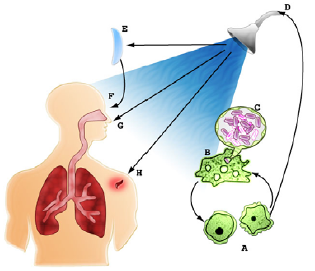Opportunistic Pathogens in Home Plumbing – Emerging Microbial Threats to Health

Dr. Joe Falkinham III (Department of Biological Sciences at Virginia Tech; Water IGEP Core) recently gave a talk at the National Academy of Sciences’ Institute of Medicine (IOM). The IOM is currently exploring imminent ‘microbial threats’ that we face to provide guidance for federal, state, and private foundation sponsored research. Find out more: Forum on Microbial Threats.
Dr. Falkinham’s talk focused on the latest findings of the ongoing collaborative research at Virginia Tech and specifically highlighted the link found between Mycobacterium in household plumbing and infections in home inhabitants. He was kind enough to give us a sneak peek into this fascinating research area. Read on:
The plumbing in our homes has a number of unique characteristics including: low disinfectant concentration, high surface to volume ratio, and pipes of different composition. In addition, the water may be heated and remain stagnant for extended periods. Research has shown that these conditions select for a group of opportunistic pathogens; namely Legionella and Mycobacterium, called opportunistic premise plumbing pathogens (OPPPs). Legionella and Mycobacterium are normal inhabitants, not contaminants, of drinking water distribution systems in hospitals, buildings, apartments, condominiums, and houses. As humans and OPPPs share habitats like showers, we are constantly exposed.
Lung disease (pneumonia or tuberculosis) can occur in individuals that are more susceptible, particularly older individuals and those with pre-existing lung conditions (COPD or cystic fibrosis). In the United States it is estimated there are 18,000 Legionella cases per year and 20,000 Mycobacterium cases per year. As the proportion of older individuals in the US continues to increase, it is expected that the number of infections will continue to increase.
In a study of 37 Mycobacterium-infected patient households, Mycobacterium were present in 22 (59 %) households and 109 of 394 (28 %) household plumbing samples. Most important, of 17 households with Mycobacterium, in 7 (41 %) the plumbing and patient isolate shared the same DNA fingerprint proving that the source of infection of the patient was their plumbing.
OPPPs are adapted to conditions in household plumbing: they are resistant to disinfection, they attach to pipe surfaces (biofilms) so are not washed out, and can grow in stagnant water of low nutrient concentration. In addition, OPPPs are not killed by amoeba in drinking water; in fact they grow in amoebae.
A number of measures have been suggested to reduce OPPP numbers in plumbing: raise hot water heater temperatures, elevate oxygen levels, and filter out OPPPs at the showerhead and water tap. Such measures might serve to reduce the chance of OPPP infection in at-risk individuals.
Event venue: Keck Center, National Academy of Sciences, Washington DC; June 17 2014
Resources: Pruden A, Edwards MA, and Falkinham, JO III (2013). State of the Science and Research Needs for Opportunistic Pathogens in Premise Plumbing. Water Research Foundation: Denver CO.


